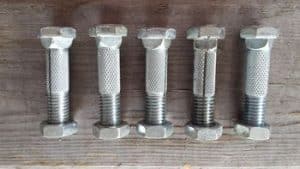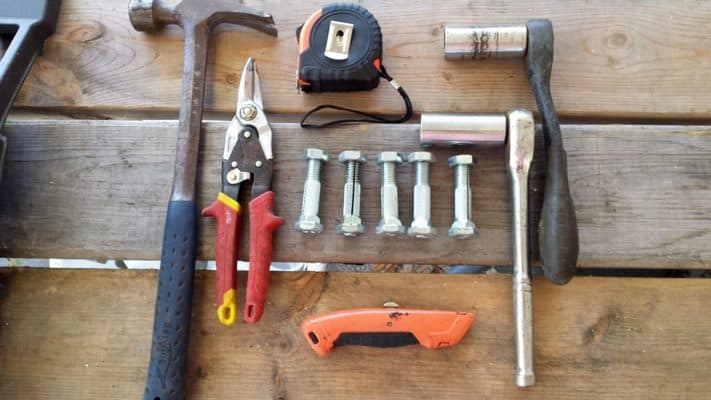What Is A Mobile Home Anchor?
Table of Contents
A mobile home anchor is a device used by installers to hold a mobile home down onto it’s pier foundation.
The anchor prevents the home from lifting up during a storm.
Anchors stop the “I” beam from moving laterally on the piers which leads to foundation failure.
Each anchor is a 5/8 inch steel shaft with a 6 inch helix on one end and an attachment point on the other.
Anchors are usually 4 ft in length with a galvanized coating. Modern anchors are installed at 5’4″ maximum on center.
Introduction To Mobile Home Anchors.
How to install a new Mobile home anchor are part of the overall tie-down system for mobile home safety.
They connect the home to the ground by connecting the anchor head to the beam structure of the mobile home.
Anchors are connected to the home with steel straps or sometimes wire cables.
Anchor Codes Upgraded In 1997 – State Code 15c
In recent years after major hurricane damage, the position and number of anchors used on mobile homes have changed. Presently a small doublewide home will need around 24 anchors spaced at 5-foot intervals along the side walls.
Extra Anchors.
Anchors are now installed at shearwall positions and along the marriage line of the two home sections. Sidewall anchors prevent wind uplift, whilst sidewall anchors prevent lateral movement.
For that reason, many homeowners are upgrading their anchors to the new standards which have proven to be quite successful in recent years.
How To Install A New Mobile Home Anchor.
Locate the anchor position. Dig a 2′ deep hole with post hole diggers. Insert the anchor shaft into the hole then turn the anchor all the way down into the ground. Only the anchor head should be showing. Backfill the hole, connect the hook to the beam, connect the strap to the anchor head and finally tighten the split bolt.
Why Would I Need A New Anchor?
Occasionally you may need to install a new mobile home anchor to replace an old, rusted or damaged tie-down. Anchors and straps are in constant contact with the ground and moisture.
Older anchors installed prior to 1997 were more than likely made of non galvanized steel which deteriorates rapidly. This is especially true in a wet area where flooding occurs and water stays under the home for any length of time.
Homes within 1000 feet of the shoreline, (Exposure “D”) are particularly at risk from saltwater moisture.
Click Here To Read: Mobile Home Plumbing | Connecting Your Plumbing Pipes.
Is Anchor Installation A Job For The Home Owner?
Yes most definitely, if you have the tools and can obtain the anchor and hardware materials.
It is a fairly simple procedure in reasonable ground conditions.
This is an important area of mobile home maintenance that is often ignored, mobile homeowners should check the condition of their tie-down system on an annual basis and make the necessary repairs.
Tools That You Will Need:
- Posthole diggers.
- Shovel.
- Metal snips.
- Tape measure.
- 2-15/16″ sockets or wrenches
Materials You Will Need:
- 1 – 4-foot galvanized anchor with a 6-inch helix.
- 24 inch piece of 2″x 4″ lumber (scrap/offcut)
- Galvanized strap.
- 1 split bolt.
- One beam strap and beam hook.
- One 3/4″ nut and bolt.

Note: Only a State licensed mobile home installer can install a mobile home in the state of Florida.
Here we are only talking about the installation an extra anchor or two where needed.
How To Mark The Anchor Location On The Ground.
Generally speaking, anchors should be position a maximum of 5’4″ on center with the last anchor no more than 24″ from each end of the home.
Mark the location of the anchor on the ground directly below the attachment point on the home or shed.
Tip: Drop a stone or a piece of dirt from the attachment point to the ground in order to locate the precise placement.
Then mark the ground 6 inches behind this 1st mark this point will be the center of the anchor and will be the location of the mobile home anchor head after its final installation.
Using The Post Hole Diggers To The Correct Depth.
Using your post hole diggers, start to dig your hole so that the bottom of the hole will be at an angle of 15 degrees towards the home. Dig down approximately 2 feet removing the excess dirt as necessary. This ensures that the anchor is turned into undisturbed soil.
Tip: Wrap a piece of tape around the post hole digger shaft to show the correct depth.
As each load is removed from the hole, place the soil in one pile next to the anchor location for later use. If you have nice grass or a patio that you need to keep clean, pile the soil into a large bucket or plastic contractor bag.
Tip: You may need to widen the access to the top of the hole in order to effectively use the post hole diggers. The sides of the hole tend to prevent the opening of the diggers.
At this point, you have a 2-foot hole into which you place the 4 foot galvanized anchor.
Installing The Mobile Home Anchor Into The Ground.
Push the anchor down into the hole as far as it will go, the anchor shaft should still be 24″ above ground.
Take the 24 inch 2″ x 4″ and place it in the slot in the anchor head. This should give you enough leverage to rotate the anchor head.
Next, you will need to turn the anchor in a clockwise direction applying some constant pressure with your body weight in a downward direction as you turn. Keep turning until the anchor head is flush with the top of the hole.
Sometimes the anchor will go in really easily if the ground is sandy but sometimes it can become difficult.
Tip: If you are finding it hard to move occasionally turn the anchor half a turn in the opposite direction to loosen up the ground, then proceed as before.
When the bottom of the anchor head is level with the top of the hole and the head points toward the home, stop turning the anchor.
Filling In The Anchor Hole The Right Way.
The bolt holes in the anchor head should be parallel to the side of the home. Out towards the sides of the anchor head as you look at it from above.
Now take the shovel fill in the top of the hole taking care to tamp down the soil every 6 inches or so to make sure that the ground is compacted and firm. This is really important, if not done correctly, the anchor will start to pull out of the ground as the split bolt is tightened up.
Tip: Use the end of the 2″ x 4″ that you used to turn the anchor to compress the soil.
Continue this procedure until the hole is completely backfilled and the anchor head rests on the soil.
Attach The Galvanized Beam Strap To The Beam.
If you are going to the trouble of changing an anchor then make sure to change the hardware which is probably also rusty and defective.
Use The New Swivel Strap Assembly.
Old staps used to be wrapped around the steel I beam this is not longer allowed.
Today installers use a premade strap with a special hook and clamp.
Attach the beam hook to the TOP of the beam. Connect the strap using the supplied 3/4″ bolt.
Pull the strap down towards the anchor head.
Connect The Strap To The Anchor Head.
Cut off the anchor strap leaving 8 inches beyond the anchor. Put the split bolt loosely into one of the square slots and turn the nut onto the bolt, one turn only for now.
Insert the strap through the slit in the split bolt with the end of the strap flush with the bolt.
Place the 15/16″ sockets onto each end of the bolts and turn until tight. The square collar on the split bolt neck should be squeezed into the square hole in the anchor head to lock the bolt in place.
Turn the split bolt until the strap is wrapped around the bolt 4-5 times and all of the slack has been removed.
Satisfactory Task Completion Check.
You now know what it takes to install a new mobile home anchor which should now be situated slightly under the home. Clear of the skirting and in line with the overhead strap attachment on the home or shed. The strap should tight with no twisting.
Must Read: Mobile Home Longitudinal And Lateral Stabilizer Devices-Are They Needed?

